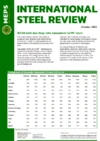Is the US steel market in overdrive?
Everyone is asking the same question, is the US steel market in overdrive? “Overcooked”, “excessive”, “too hot” are just a handful of phrases uttered by coil buyers to describe the current market. It is no surprise that steel prices have surged since the summer. The market went into its shell at the beginning of the Covid-19 pandemic and only started to come out of it in August.
Sentiment is always the driver of any industry, let alone the steel industry. During the initial virus outbreak, investors backed off with on-the-table projects, and buyers collectively tried, in vain in some instances, to cancel orders on the steel mills or decided not to place any bookings. Integrated and scrap-based mills were forced to cut their production due to waning demand forecasts.
Yes, hindsight is an exact science, however, steel markets are inevitably cyclical. Eventually they change direction, including in periods that are, to use a cliché, unprecedented. What happened from August onwards is no exception.
US steel buyers realised, too late in many cases, that when demand drops like a dead weight falling off a cliff, there will always be a resurgence sooner or later. Reacting too slowly to market moves can often be detrimental to one’s purchasing patterns, stock levels and ultimately profit margins.
On the other hand, those that understood their forecast models and what factors were contributing to the downward cycle, are probably those that came out of this smiling, in a big way.
Demand outstrips supply
The steel producers are constantly looking at their output versus the level of market demand, but it is often the case that the buyers who place the orders on the mills are the ones dictating the price. However, a pull back from order placement will directly result in capacity cutting by the steelmakers, eventually tightening supply sufficiently for the pricing pendulum to swing back in the producers’ favour.
Consider this, US capacity utilisation at the of end October 2019 was reported at 80.7%, but averaged only 55% during the April to August 2020 period. It currently stands at 67.9%, which is certainly much improved from the spring/summer levels, but still well below normal operations. It is clear that demand has recovered faster than supply.
But will the rally in US steel prices last? If the old adage of what goes up must come down holds true, then no it won’t. The market needed a correction, but as is often the case in the US, the sentiment-driven peaks and troughs regularly surpass what would be expected if fundamentals were the sole factor involved in determining price movements.
Although the upward correction may be sustained for a while longer, it will not last forever. Markets can take a while to settle down from extraordinary events, such as the coronavirus pandemic, and the steel market is no exception.
When the mills revert to 80% plus capacity utilisation, then we can consider that the steel industry has returned to some degree of normality. But even when that time does come, don’t expect price volatility to disappear.

Source:
International Steel Review
The MEPS International Steel Review is an essential monthly publication, offering professional analysis and insight into carbon steel prices around the world.
Go to productRequest a free publication





